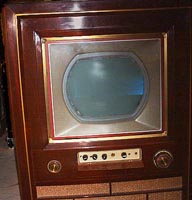THE SET18 October 2006The Sixth Year August 2005 to October 2006 devoted to anything related to vintage color TV.  Goodbye  15GP22 with Color Bars 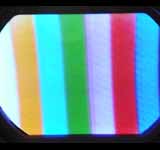  Let's start off Tidbits V with a Merrill trivia question. Answer is... If you purchased a CT-100 in, say the Fall of 1954, and if it were one of the upper serial number CT-100's such as B8003911, how many rubber bands would you expect to be a part of the set's configuration ?  Lame? Boring? Tough! here's another...  ...and yet another: When a Merrill weathers, it becomes highly susceptible to the elements of time, temperature, and humidity. In particular, a cover at the rear of the vertical and horizontal deflection coils becomes brittle, warped, flakey, and cracked with passing years. Here are two photographs taken in 2005 of two different yokes from two different CT-100's that lived their first fifty years of life in two very different environments. ? _ ?  On a roll... When heat's the enemy, I use this tool that cools... ?  Unedited Email But these are very close to what came off the modem.] From: "John F. Pinckney" Subject:Re: CBS Drawing Package EXCERPT PDF Date: Sun, 28 Aug 2005 04:22:02 +0000 Hi Pete, First off, let me say that the first time I saw a "restored" CT-100 was 35 years ago back when I was in high school. (OK, so being interested in antique color TV sets wasn't "cool" back then. But, I was blown away by the "color fidelity" compared what I'd become accustomed to.) The electronics vocational class of a nearby high school had restored a CT-100 as a "project".... Wish they had that in HS when I went! Thanks for another 'new' CT-100 recollection. --Pete  A Lucky Thirteen! CBS Crosley Emerson General Electric Hallicrafter Hazeltine Motorola Philco RCA Sylvania Westinghouse Zenith Incidentally, Jack Gould, 'media' critic of "The NY Times" who witnessed the demonstrations, wrote -- and perhaps for the first time in print -- that he Never Twice Saw the same Color! Well, no, he didn't use those words exactly, but what a prescient observation. Here's exactly what he did say: There was considerable variation in color shadings among the different sets.... That statement also illustrates something that happens quite often in 1953-1954 descriptions of NTSC color images. If I try to tie terms a critic uses to the technical underpinnings of the hardware, thereÔÇÖs no shortage of head-scratching! To what does 'shadings' refer? Was the 'variation' in hue, saturation, convergence, purity, or some combination thereof?  Whatever happened to... I recall the Philadelphia RCA distributor had a promotion sometime in 1955-56 providing a free CT-100 to service dealers who bought a load (500ÔÇô1000) of receiving tubes. It put a lot of color sets out there and gave dealers some experience. It also cleared out the warehouse to make room for the 21-inch CT660 series.  ...Stats Current statistics covering early color television sets can be viewed through these links:Steve McVoy's site This Site: Number of Surviving CT-100 Television Sets   Now Just a Darn Minute... The sun's up. The room is bright. It's already 8:30 Monday morning. A CT-100 struts its stuff against a newbie wide-screen 720p live broadcast, fifty-one years after the Merrill was built. 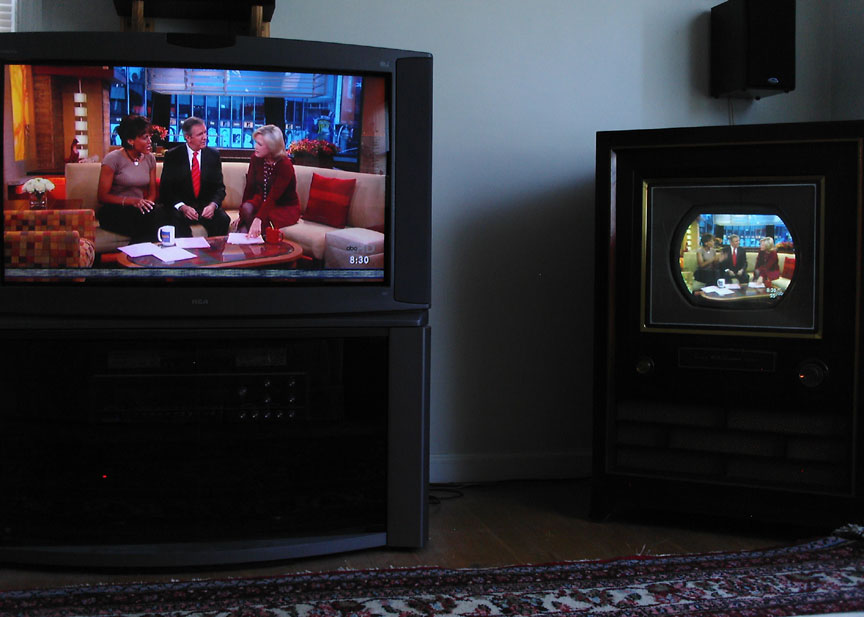 Both are over-the-air broadcasts from WABC New York. ATSC = UHF 45. NTSC = VHF 7.  Stuff about early color manufacturers and who may have actually sold color sets...
 The Science of Controlling Reflections for Early Color Television  How to Take a Screenshot do cousins of color bars -cartoons- make good subjects? 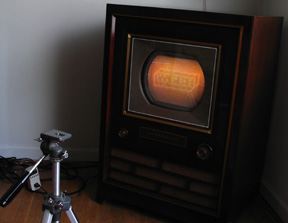  Forget plasma, LCD, and even DLP. flat-screen TV just a variation of the first color CRT? SED is the future darling of the big-, flat-, wide-screen TV industry because SID images are just as sharp as the traditional cathode ray tube. [IMO, the direct-view delta-gun CRT computer monitor still produces the best high-resolution consumer video image.] SED stands for Surface-conduction Electron-emitter Display, and it is very similar to CRT technology. It generates a picture when electrons collide with a phosphor-coated screen. But instead of using three electron guns, SED technology employs a large array of tiny electron guns; SID calls them emitters -- one for each pixel on the display. Of course, tricolor CRTs beam electrons from the back of the bottle, but SED emitters are on a plate located extremely close to the phosphor-coated faceplate. That means a much slimmer TV can be built with a much larger viewing area than is possible with CRT technology. Toshiba may have a 55-incher on the market in 2006. The future of high-quality flat-screen video may just be a variation of the venerable 15GP22.  January 2, 2006. We werenÔÇÖt really buddies, but that day he was my best friend. I got invited to watch the Rose Bowl Parade by the rich kid on the block; his father was an undertaker and adequately well off to own what was probably the only black metal table-model RCA color television in south Bethlehem, PA. It was January 1, 1958. What a treat. A vivid memory of my first look at the parade is a long shot of a smattering of red roses. With me at the faceplate studying the red phosphor dots that made up those distant flowers, probably only the manners of my host kept me from being chided for blocking everyoneÔÇÖs view. Today it's exactly 48-years and a day later and a chance to relive the event with vintage roundie CT-100 B8000194. But it rained on my parade. For the first time since 1955, Pasadena faced a wet one. While not what I had hoped for, hereÔÇÖs a little of what it looked like. Click here. For a look at what 2007 wrought, click here.  Time Marches On... Bloomington's TV assembly line ÔÇö the world's first color television manufacturing facility and still the largest on the planet ÔÇö first came to life 57 years ago. Thomson Consumer Electronics (which makes the RCA product line) announced that the Bloomington factory will move to Juarez, Mexico, on April 1, 1998. 2005: A sprawling plant that used to crank out thousands of televisions sets is gearing up to cook up millions of hamster ovary cells. Gone from the factory are the picture tubes and circuit boards. In their place are huge stainless steel vats where hamster cells are brewed with the goal of producing proteins for breakthrough new medicines. Cook Pharmica renovated the former RCA television assembly plant to create the 124,000-square-foot facility. At one time, the building housed the worldÔÇÖs largest color television assembly plant. Their conversion of the RCA plant took 10 months. They are on pace to start making regulatory-compliant drugs by fall 2006.   Echoes of Historic NTSC Color Broadcasts  Unedited Email But these are very close to what came off the modem.] From: Mal Fuller To: CT-100 Pete Subject: annoyance found in the CTC-5 Date: Tue, 14 Mar 2006 02:48:27 +0000 Hi Pete, ...I'm not sure that this is the forum for it, but I know a very worthwhile modification for the CTC-5. ItÔÇÖs reversible and should really improve the setÔÇÖs value anyway since it cures an odd annoyance found only in the CTC-5. It was the first television from RCA since the 1946 630-TS to have an annoying interaction between the brightness and contrast (picture) controls. As the contrast was advanced, the brightness had to be retarded and, conversely, when the contrast was reduced, the brightness had to be advanced. It took two hands really. The mod is to rewire the contrast and brightness controls so that the controls and the Y output (video output) circuit duplicate the circuit used in a CTC-7, 9, 10(remote) 11, and perhaps even later. No components are removed or added, only wired slightly differently. This makes the contrast and brightness operate pretty much independently of one another. An added bonus is that grey scale tracking is far superior and easier to achieve after this change is made. Later, Mal   Still under vacuum, this tricolor CRT is on the West coast, near Tacoma. Tube mated with Living CT-100 list Merrill number 113.  FOR ADMIRAL MODEL CA 100 COLOR ADAPTER ONLY  Here's something I wrote for an AudioKarma thread. August 15, 2006 More '53 color sleuthing... This thread seems to have become aligned with a quest of mine: trying to discover what 1953 NTSC color actually looks (looked) like. To that end, this morning I did another side-by-side comparison between the CT-100 and a modern HDTV operating in NTSC mode, with both sets driven by the same OTA rooftop antenna. As inspired by old-tv-nut earlier in the thread, I balanced the sets in terms of brightness, contrast, color, and tint. This meant pushing the CT-100 to a point just below where, on super-bright screens, the raster begins to bloom when the load is so great the 6BD4 H-V regulator can no longer maintain adequate ultor voltage (which occur quite often but usually only in commercials where the screen is driven very white with only a minor amount of pastel text). Conversely, the HDTV set was throttled back to match brightness and contrast and color of its elder. In a nutshell: CT-100 displays better white than the modern set, which tends to reproduce more 'eggshell' in hue than the CT-100's white. CT-100 displays more saturated blue than the modern set, which seems to reproduce a less 'bright' blue of possibly even a different hue. CT-100 displays a less bright red than the modern set, which tends to reproduce the 'red' with a clear shift in hue towards orange. CT-100 seems to display green with greater saturation in general and hue seems to be simply more 'green' than the modern set. Finally, it's important to remember that these observations were made with sets that were adjusted to produce pictures that look identical most of the time. The 'greens' matched each other. Ditto the blue and red. Only occasionally would a given hue be different between the two sets. The above observations were made watching PBS kid's shows on channel 13 from NYC. -------------------------------- A further observation was made this morning watching GMA on channel 7 from NYC. Here the cameras are HDTV where the camera matrix, if I interpret old-tv-net correctly, mates the camera and modern HDTV-spec phosphors. In a nutshell: Much of the GMA studio has colors that do not translate from HDTV to 1953 NTSC very well. Areas of the GMA set swing very bright on the CT-100, away from the subdued orange-like hue, and on almost to white. This is the only OTA video I've seen that shows a striking difference between the two television standards. [I wanted to switch the modern set between NTSC and ATSC modes to confirm that there was essentially no visual difference between the two, but the ABC digital transmitter (ch. 45 in NYC) was either off the air or another channel 45 from somewhere skipped in and swamped my ATSC front end. [the ATSC-equivalent of FM capture ratio must suck!]  Another bullet was added on August 21 '06 to the above entry entitled "Stuff about early color manufacturers and who may have actually sold color sets..." Here's that new added info followed by an anecdote of my own: PPS from John Folsom
That year, I recall a small crowd around a color console in the Sears retail store on Rt. 73 in N-E Philadelphia. I slipped into the group and cut my way to the front where a 21-in. roundie Silvertone wowed the crowd, but with its hue control cranked fully clockwise! Television in color was so new and created so much curiosity that these people were hooked to a stupid hue-distorted image. Yes, I did adjust it, clearly surprising the color-starved crowd who had been trying to make sense of the screwy colors on the screen.  United Email But these are very close to what came off the modem.] From: Gregg Boodnaruk Subject: Re: == ct-100 on ebay 9-8-06 == Date: Tue, 12 Sep 2006 00:24:33 +0000 Hi Pete, I saw one of those sets [CT-100] running back when I was in high school. I'm from New York, and I took a BOCES, where we learned TV servicing on round-screen tube color sets. My instructor had one CT-100 and cranked it up for every Open House. It ran my first year, but the Selenium Rectifier fried the second year, then the instructor retired, then a few years later they caned TV repair all together. I graduated in '80. Then, a few years back a CT-100 sold on eBay for about $5,000, and I found your site and remembered that CT-100 back at school and our instructor Joe King, who knew about it. He was a great guy to learn from. King would set it up in the equipment closet and turn it on a few days before Open House and "let it cook" as he use to put it: a term he used every time one of us "fixed" a TV in class. It wasn't really fixed until it "cooked" for a few days. I remember the picture on that CT-100 back at BOCES was pretty nice. It was hard to get one of the newer sets (1980s) to look good next to it. Greg  Whirling Wratten Wheels... 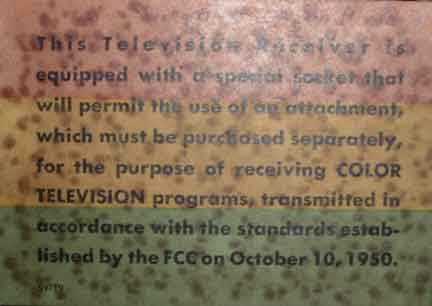
What with the rebirth of a stillborn color TV system that was seen briefly in the summer of 1951 -- the October 1950 FCC-approved CBS sequential color-wheel system -- it behooves us to use correct historical terms in our discussions. To that end, manufacturers in 1951 used the non-interchangeable terms 'adapter' and 'converter.' Thanks to historian Ed Reitan, who interprets and defines the terminology as delineated by CBS testimony at the FCC hearings: Color 'adapters' were the electronic add-on boxes and modifications to existing receivers that allowed those conventional black-and-white receivers to display 405-line, 144-field/s CBS Color Television programs in black-and-white. Color 'converters' were the color wheels, with driving electronics, that could be used in conjunction with 'adapted' receivers to show the CBS Color programs in color. They were meant to sit in front of an adapted receiver. Color 'companions' (aka color 'slaves') were CBS color monitors that stood next to, and received video from, an existing monochrome receiver. These color units had their own picture tube, video amplification, color wheel, wheel synchronizing circuitry, and high-voltage and deflection system. Audio was supplied by the monochrome receiver. Color companions, although planned for sale, were never released for sale. [A good thing, for it was an inherently foolish concept: who would have wanted two bulky television consoles in one living room.] Color 'combinations' (aka 'dual receivers') were the receivers that could be manually switched to receive either NTSC monochrome (525-line, 60-field/s) or CBS color (405-line, 144-field/s) standards. This was the only unit eventually commercially sold (for only a short time) as the CBS-Columbia Model 12CC2 Receiver. When in the color mode, its two filter wheels rotated in front of the picture tube at 1440 RPM in a red, blue, green sequence. When in the monochrome mode, the wheels stopped to allow direct viewing of its black and white picture tube through clear sections.  Thanks to Steve Dichter for locating this 'New York Times" ad for another early 15-in. color television set.  Ka-ter-aK Restorers develop processes to fix these so-called 'cataracts.' One such technique is shown in this link, which was written and photographed by vintage color collector Doug Harland. Used with Doug's kind permission. [click here] [Created 9-3-2005] 
|

